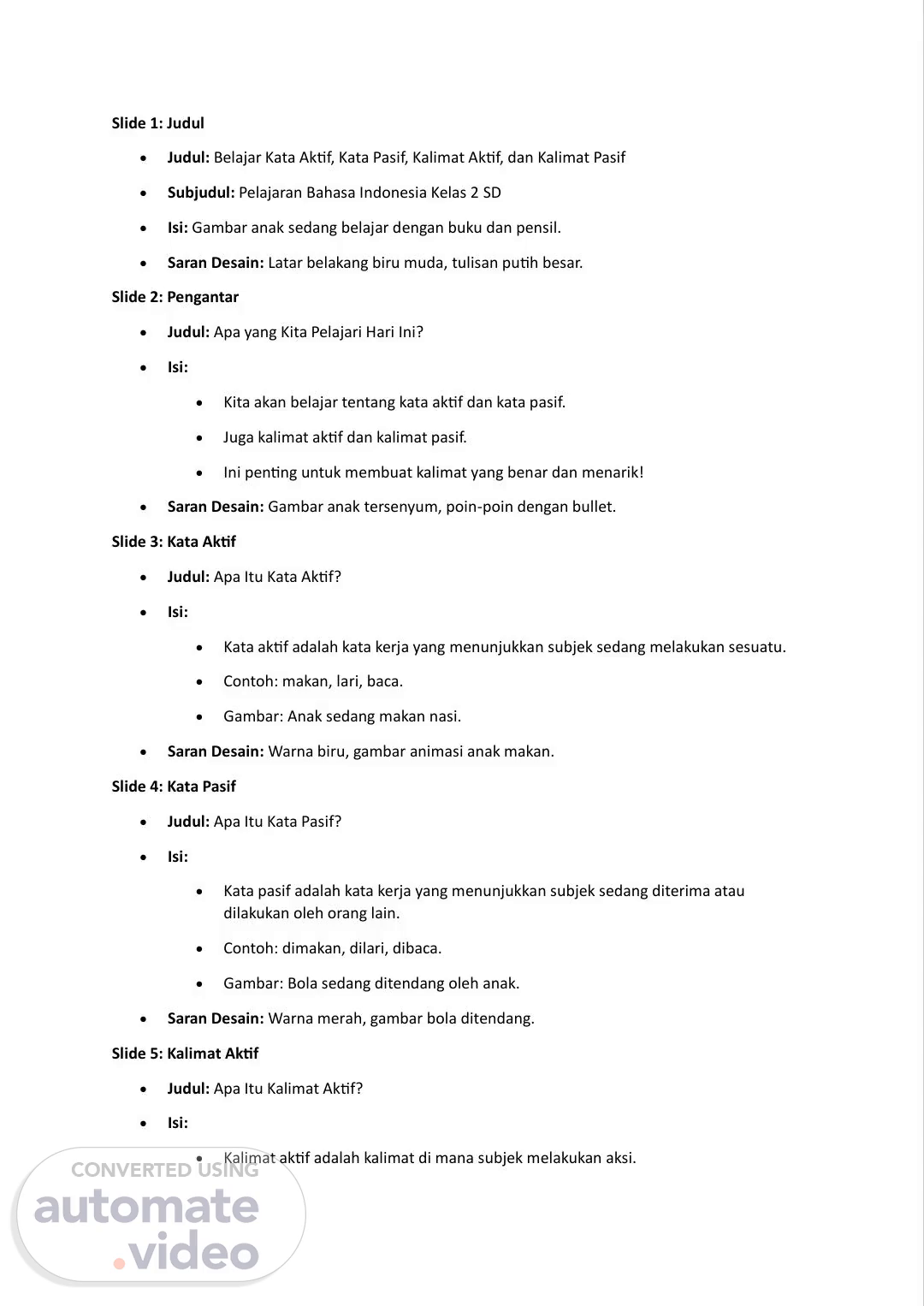Scene 1 (0s)
[Audio] Slide 1: Title Title: Learning Active Words, Passive Words, Active Sentences, and Passive Sentences Subtitle: Indonesian Language Lesson for 2nd Grade Elementary School Content: Picture of a child studying with a book and pencil. Design Suggestions: Light blue background, large white font. Slide 2: Introduction Title: What Are We Learning Today? Content: We will be learning about active words and passive words. As well as active sentences and passive sentences. This is important for creating correct and engaging sentences! Design Suggestions: Picture of a smiling child, bullet points. Slide 3: Active Words Title: What Are Active Words? Content: Active words are verbs that show the subject is doing something. Examples: eat, run, read. Picture: A child eating rice. Design Suggestions: Blue color, animated picture of a child eating. Slide 4: Passive Words Title: What Are Passive Words? Content: Passive words are verbs that show the subject is being received or done by someone else. Examples: eaten, run, read. Picture: A ball being kicked by a child. Design Suggestions: Red color, picture of a ball being kicked. Slide 5: Active Sentences Title: What Are Active Sentences? Content: Active sentences are sentences in which the subject is performing the action..
Scene 2 (1m 40s)
[Audio] Structure: Subject plus Active Verb plus Object. Example: Ani eats rice. (Ani performs the action eat.) Design suggestion: Picture of Ani eating, arrow pointing to subject. Slide 6: Passive Sentence Title: What is a Passive Sentence? Content: A passive sentence is a sentence where the subject receives the action. Structure: Subject plus Passive Verb plus By plus Agent. Example: Rice is eaten by Ani. (Rice is received the action eat by Ani.) Design suggestion: Picture of rice being eaten, arrow pointing to subject. Slide 7: Examples of Words and Sentences Title: See the Examples! Content: Active Word: eat → Active Sentence: Budi eats an apple. Passive Word: eaten → Passive Sentence: An apple is eaten by Budi. Active Word: write → Active Sentence: Siti writes a letter. Passive Word: written → Passive Sentence: A letter is written by Siti. Design suggestion: Simple table with pictures of a fruit and a letter. Slide 8: Difference between Active and Passive Title: What's the Difference? Content: Active: Strong subject, performs the action (blue). Passive: Weak subject, receives the action (red). Remember: Active words do not use di, passive words use di. Design suggestion: Comparison diagram with icons. Slide 9: Practice Together Title: Let's Practice! Content: Change active word into passive: eat → eaten. Create an active sentence: The child runs in the park. Create a passive sentence: The book is read by the teacher. Design suggestion: Interactive exercise with instructions..
Scene 3 (3m 39s)
[Audio] Design Tips: Interactive, ask students to answer in class. Slide 10: Quiz Questions 1-5 Title: It's Quiz Time! Content: Question 1: What is this word? (Picture of child eating) Answer: active. Question 2: Change drink to passive. Answer: drank. Question 3: Make an active sentence from the ball was kicked. Answer: The child kicks the ball. Question 4: What type of sentence is The book is read by Ani? Answer: passive. Question 5: The active form of written is? Answer: write. Design Tip: Image for each question, hidden answer (click to reveal). Slide 11: Quiz Questions 6-10 Title: Advanced Quiz! Content: Question 6: Active sentence: The teacher explains the lesson. Answer: correct. Question 7: Change to passive: The cat is eating fish. Answer: The fish is being eaten by the cat. Question 8: The passive form of read is? Answer: read. Question 9: What is the subject in the passive sentence The house is being built by the builder? Answer: the house. Question 10: Make a passive sentence from The child is playing with the ball. Answer: The ball is being played with by the child. Design Tip: Same as previous slide, add animation for answers. Slide 12: Conclusion Title: What Have We Learned? Content: Active words: perform an action. Passive words: receive an action. Active sentences: strong subject. Passive sentences: weak subject. Keep practicing! Design Tip: Image of child clapping, summary of key points. Slide 13: Thank You Title: Thank You! Content: We hope you enjoyed learning Indonesian. See you in the next lesson!.
Scene 4 (5m 47s)
[Audio] Design Proposal: Classroom layout, background music if possible..
